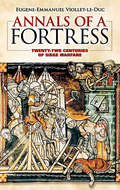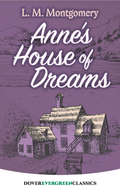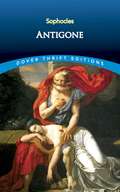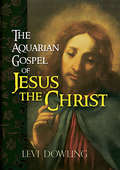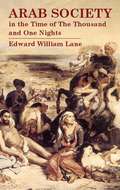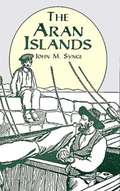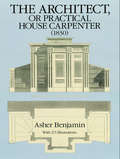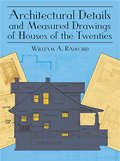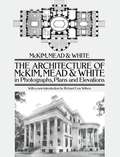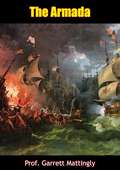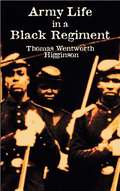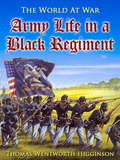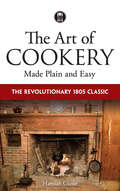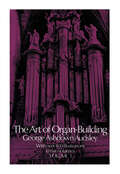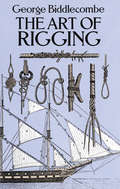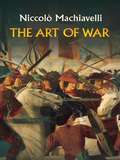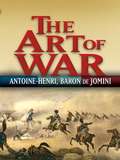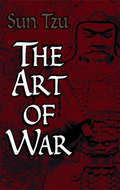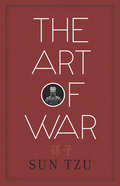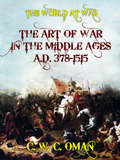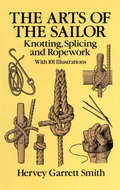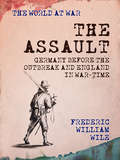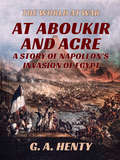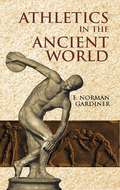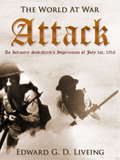- Table View
- List View
Annals of a Fortress: Twenty-two Centuries of Siege Warfare
by Eugene-Emmanuel Viollet-le-Duc Benjamin BucknallCombining the excitement of a novel with the authenticity of a historical document, this gripping book chronicles a castle's rise from obscurity to international attention during the nineteenth century. It profiles a fictional fortress, La Roche-Pont, for an unusual survey of the evolving art of siege warfare--from Gallic tribes attempting to hold off the might of the Roman empire through medieval feuds, protracted religious conflicts of the seventeenth century, and the Napoleonic and Franco-Prussian Wars.The noted architect Eugene-Emmanuel Viollet-le-Duc (1814-1879) was in a unique position to write this book. A central figure in France's Gothic Revival, Viollet-le-Duc had a second career in the military that included a prominent role in the defense of Paris during the Franco-Prussian War of the 1870s. With this accessible, well-researched study, he exerted an enduring influence on French military defensive thinking. Subtle and enchanting in its blend of fact and fiction, Annals of a Fortress continues to offer a brilliant evocation of more than 2,000 years of European warfare.
Anne's House of Dreams: Annotated Edition (Dover Children's Evergreen Classics #5)
by L. M. MontgomeryIn this fifth book of the Anne of Green Gables series, our red-haired heroine finally marries her childhood sweetheart and true love, Gilbert Blythe. After a ceremony in the sunshine of the old orchard at Green Gables, surrounded by the loving faces of long-familiar friends, the young doctor and his bride set off for the mist-shrouded shores of Four Winds Harbor.The newlyweds settle in a quaint fishing village, where their snug home offers views of the sea from every window. The new setting provides a fresh opportunity for Anne to discover kindred spirits: lighthouse keeper Captain Jim, teller of enchanting tales; bitter-tongued but kind-hearted Miss Cornelia, who bears an enduring grudge against men and Methodists; fascinating Leslie Moore, trapped in a loveless marriage, who envies and admires Anne; and writer Owen Ford, who seeks inspiration for his great Canadian novel. Poignant, romantic, and brimming with old-fashioned charm, Anne's House of Dreams traces the beloved heroine's path to maturity.
Antigone
by SophoclesIn his long life, Sophocles (born ca. 496 B.C., died after 413) wrote more than one hundred plays. Of these, seven complete tragedies remain, among them the famed Oedipus Rex and Oedipus at Colonus. In Antigone, he reveals the fate that befalls the children of Oedipus. With its passionate speeches and sensitive probing of moral and philosophical issues, this powerful drama enthralled its first Athenian audiences and won great honors for Sophocles.The setting of the play is Thebes. Polynices, son of Oedipus, has led a rebellious army against his brother, Eteocles, ruler of Thebes. Both have died in single combat. When Creon, their uncle, assumes rule, he commands that the body of the rebel Polynices be left unburied and unmourned, and warns that anyone who tampers with his decree will be put to death.Antigone, sister of Polynices, defies Creon's order and buries her brother, claiming that she honors first the laws of the gods. Enraged, Creon condemns her to be sealed in a cave and left to die. How the gods take their revenge on Creon provides the gripping denouement to this compelling tragedy, which remains today one of the most frequently performed of classical Greek dramas.
The Aquarian Gospel of Jesus the Christ
by Levi DowlingThis visionary text professes to tell the complete story of Jesus' life, including the "lost" years, during which he traveled and studied in Tibet, Egypt, India, Persia, and Greece. First published in 1908, this mystical work is the cornerstone of a Christian denomination, the Aquarian Christine Church Universal, and it offers intriguing, controversial assertions about Christ's message.Jesus was conceived by a human father, author Levi Dowling states, and by effort and prayer rendered himself a fit vessel for "the Christ" -- the model for human existence and ultimate salvation. Dowling, who devoted forty years of preparation to the task of transcribing this volume's contents from original Akashic records, further asserts the reality of reincarnation and its culmination in the perfection of the human soul. Tracing Jesus' life from his birth in Bethlehem to his ascension from the Mount of Olives, Dowling offers complete details concerning the savior's years among monks, wise men, and seers throughout the Orient. Readers with an interest in occult lore and the history of religion will find this remarkable volume a source of endless fascination.
Arab Society in the Time of The Thousand and One Nights
by Edward William LaneElaborate, explanatory notes from the author's 1859 translation of the Arabian Nights comprise a virtual encyclopedia of Middle Eastern life. Intriguing account of Islamic society as it existed during the Middle Ages considers importance of religion, literature, festivals, education, slavery, role of women in society, and rituals observed for the dead.
The Aran Islands
by J. M. SyngePlaywright John M. Synge visited an isolated group of islands west of Ireland, where he drew inspiration from local folklore and anecdotes. This memorable record of Synge's days amid the islanders and their tales of fairies and Celtic heroes offers an enchanting portrait of Irish cultural renaissance.
The Architect, or Practical House Carpenter (Dover Architecture #1830)
by Asher BenjaminThe superbly illustrated and detailed handbook that popularized the use of classic Greek architectural style in America in the early and middle 1800s. 271 illustrations.
Architectural Details and Measured Drawings of Houses of the Twenties
by William A. RadfordProvides details for frame houses, houses of brick, brick veneer, stucco, etc., as well as plans for barns, silos, ice houses, and other farm structures. Also includes plans for such interior features as built-in buffets and sideboards, kitchen cabinets, wardrobes, window seats, breakfast nooks, fireplaces, and more. 154 black-and-white illustrations.
The Architecture of McKim, Mead & White in Photographs, Plans and Elevations
by Mead White McKimThe roster of McKim, Mead & White's clients reads like a who's-who of American business, professional, cultural, and social enterprise in the late nineteenth and early twentieth centuries. Many of the buildings designed by this distinguished New York firm still stand today — libraries, museums, churches, train stations, banks, office buildings, private clubs, and residences — an imposing testament to the splendor and durability of its achievement.This magnificent pictorial history is one of the most important documents in the history of American architecture. In 435 superb photographs and over 500 line illustrations, including both floor plans and elevations, it surveys over 160 structures designed by the architects of McKim, Mead & White. Originally published in four massive volumes and now available in an unabridged one-volume paperback edition, this handsome book depicts such famous New York City landmarks (present and former) as Columbia University's Low Library, the Pierpont Morgan Library, the Municipal Building, the second Madison Square Garden, and the original Pennsylvania Station.Other major landmarks include private and public buildings and other structures in Boston, Cambridge, Newport, Providence, Princeton, Philadelphia, Washington, D.C., Chicago, and Montreal. For architects and architectural historians, this book will be a valuable source for its comprehensive views of an unrivaled achievement in American architecture. Social historians and students of Americana will find it revealing for its reflection of the ideas and culture of the times. A new Introduction by Richard Guy Wilson perceptively appraises the McKim, Mead & White legacy for today's readers.
The Armada
by Prof. Garrett MattinglyWINNER OF THE SPECIAL CITATION FROM THE PULITZER PRIZE COMMITTEEIn 1588, the English fleet defeated the mighty Spanish Armada in the sea battle that author Garrett Mattingly refers to as “the focus of the first great international crisis in modern history.”Winner of 1960 Pulitzer Prize and a model history as important to the scholar as it is engrossing for the general reader, Mattingly’s 1959 book The Armada is the definitive story of that battle and its meaning.
Army Life in a Black Regiment (Civil War)
by Thomas Wentworth Higginson"Army Life in a Black Regiment has some claim to be the best written narrative to come from the Union [side] during the Civil War. Higginson's picture of the battle which was the origin of "praise the Lord and pass the ammunition" and his reading of the Emancipation Proclamation to the black regiment are unsurpassed for eloquence." — historian Henry Steele CommagerOriginally a series of essays, this important volume was written by a Union colonel from New England, in charge of African-American troops training on the Sea Islands off the coast of the Carolinas. A lively and detailed wartime diary, the book offers a refreshing portrait of life in the Union Army from an officer's point of view, recording opinions of other commanders and capturing the raw humor that develops among the men in combat. Higginson's descriptions of the soldiers, routines of camp life, and southern landscapes are unforgettable, as is the account of his near escape from a cannon ball. An unusual historical document intended to introduce new generations of readers to an American past that should not be forgotten, Army Life in a Black Regiment will be invaluable to students of Black History and the American Civil War.
Army Life in a Black Regiment (The World At War)
by Thomas Wentworth HigginsonThomas Wentworth Higginson (December 22, 1823 – May 9, 1911) was an American Unitarian minister, author, abolitionist, and soldier. He was active in the American Abolitionism movement during the 1840s and 1850s, identifying himself with disunion and militant abolitionism. He was a member of the Secret Six who supported John Brown. During the Civil War, he served as colonel of the 1st South Carolina Volunteers, the first federally authorised black regiment, from 1862–1864. Following the war, Higginson devoted much of the rest of his life to fighting for the rights of freed slaves, women and other disfranchised peoples. (Excerpt from Wikipedia)
The Art of Cookery Made Plain and Easy: The Revolutionary 1805 Classic
by Hannah Glasse"A very interesting glimpse at everyday cooking in the daily life of 18th–19th century England, with many helpful tips, tricks, and recipes (for the day). The language is enjoyable and the information contained is substantial." — Jefferson-Madison Regional Library SystemRevised and republished many times since its 1747 debut, this cookbook was a bestseller in England and the United States for more than 100 years. George Washington and Thomas Jefferson owned copies, and Benjamin Franklin even translated some of its recipes into French in hopes of attaining a taste of home while abroad. Author Hannah Glasse dismisses French cookery, the leading cuisine of her day, as inefficient for servants and middle- to lower-class cooks, citing its fussiness, expense, and waste. Instead, Mrs. Glasse focuses on standard Anglo-American fare, from soups and gravies to cakes and jellies, all simple dishes, prepared in a straightforward manner. In addition to practical advice on meat selection, carving, and basic cooking skills, this historically fascinating document offers tips on preparing food for the ill, cooking and food storage on ships, and making soaps and scents for the home. Historians, cooks, and all lovers of gastronomy will appreciate this glimpse into the kitchens of a bygone era.
The Art of Organ Building
by George Ashdown AudsleyVolume 1 of the fullest repository on organ building and history in English language. Includes outline of organ history, external design and decoration, internal arrangement and mechanical systems, acoustics and theories of sound-production in organ pipes, tonal structure and appointment, compound stops of the organ, more. Complete with illustrations, tables, and specifications. "the most significant republication in our field for the past twenty years . . . an incomparable, invaluable book." -- American Guild of Organists Quarterly.
The Art of Rigging
by George Biddlecombe"Few, today, can realize how important was the art of rigging a ship and reeving her gear in the days just old when all aloft was wood and hemp; or how great the part it has played in the building of Empire." — Introduction.Although mastery of the art of rigging is no longer required on board today's ships, legions of serious model ship builders who wish to rig their ships correctly need to learn the art in miniature. This book is widely considered the best manual ever produced on rigging the sailing ship. It is based on the extensively revised and updated 1848 edition prepared by Captain George Biddlecombe, a Master in the Royal Navy and former merchant seaman. The book is divided into five parts:The First Part contains an alphabetical explanation of terms and phrases used in rigging. The Second Part consists of directions for the performance of operations incidental to rigging and preparing it on shore, with a table of the comparative strength of chain and rope. The Third Part contains the progressive method of rigging ships. The Fourth Part contains a description of reeving the running rigging and bending the sails in addition to the rigging of brigs, yachts, and small vessels. The Fifth Part comprises tables of the quantities and dimensions of the standing and running rigging of ships, brigs, fore-and-aft schooners, and cutters, with the species, size, and number of blocks, hearts, dead-eyes, etc.Serious modelists, naval historians, armchair skippers — any sailing buff — will want to own a copy of The Art of Rigging. Complete and wonderfully clear, it is now available in its first inexpensive paperback edition. It belongs in every maritime library.
The Art of War
by Henry Neville Niccolò MachiavelliFlorentine statesman, writer, and political theorist, Niccolò Machiavelli (1469-1527) considered The Art of War his most important work. Five centuries later, after serving as a guide to Frederick the Great, Napoleon, and countless other military leaders, it remains an authoritative treatise on the fundamentals of warfare.Best known as the political theorist who wrote The Prince, Machiavelli used this book to advocate strategies for Italy's increased military prowess and political strength. Machiavelli was the first to propose a global context for the functional unity of war and politics, with the former serving as an instrument of the latter. Written in the form of dialogues, this 1520 work represents a humanistic treatment rather than a textbook approach. It clearly states and discusses the fundamentals of military organization and strategy: handling recruitment and weapons, motivating troops, demoralizing enemies, and achieving tactical and strategic advantages. Essential to the education of students of military history, strategy, and theory, The Art of War continues to inspire readers.
The Art of War
by W. P. Craighill Antoine-Henri Jomini G. H. MendellAn eyewitness to most of the important battles of the Napoleonic Wars, Baron Antoine Henri de Jomini served with both the French and the Anglo-Allied armies. His firsthand accounts of the conflicts are the most authoritative ever written, hailed by experts as both accurate and insightful. It endures as the definitive work on strategy and tactics and as a fundamental source of modern military thought. In fact, generals on both sides of the American Civil War were well schooled in The Art of War. Jomini approaches warfare from several directions, including strategy, tactics, logistics, engineering, and diplomacy. He examines each in turn, and he offers an analysis of strategic problems posed by a variety of theaters and terrains, the tactics of attack and defense, surprise maneuvers, special operations, the importance of reconnaissance, and the deployment of forces.Few can match the breadth of advice offered by the man who was critical to the success of both Napoleon and Czar Alexander I. Unsurpassed in its influence on military thinking, doctrine, and vocabulary, Jomini's classic remains both a historic and practical guide to students of warfare.
The Art of War
by Sun TzuPreserved in China for more than 2,000 years before it was brought to the West by the French, this compact little book is widely regarded as the oldest military treatise in the world. Rumored to have been used by Napoleon in his campaigns to conquer Europe, it today retains much of its original merit. American officers read it closely during World War II. The Japanese army studied the work for decades, and many 20th-century Chinese officers are said to have known the book by heart. More recently, it has also been viewed as a valuable guide to competing successfully in business.Stressing the importance of attacking your enemy when he is unprepared and scheming to discover his plans, the author advises avoiding the strong and striking at the weak, and using spies for every kind of business. Principles of strategy, tactics, maneuvering, and communications, the treatment of soldiers, the importance of strong troops and well-trained officers, and the administration of rewards and punishments all have a modern ring to them.A valuable guide to the conduct of war, this classic of military strategy is indispensable to military personnel, history enthusiasts, and anyone intrigued by competition and rivalry.
The Art of War (Penguin Modern Classics #909)
by Sun TzuRegarded as the world's oldest military treatise, this compact volume has instructed officers and tacticians for more than 2,000 years. From its origins in China, The Art of War traveled the world to inform the strategies of Napoleon and World War II generals. More recently, it has taken on a new life as a guide to competing successfully in business, law, and sports.All of The Art of War's concepts retain their value to modern readers, from the prudence of circumventing a strong opponent and taking advantage of a weak one to the wisdom of preparedness and flexibility. Other topics include strategy, tactics, maneuvering, communications, the treatment of soldiers, and the worth of well-trained officers. History enthusiasts, business thought leaders, and anyone intrigued by competition and rivalry will appreciate this elegant edition of the classic work.
The Art of War in the Middle Ages A.D. 378-1515: A. D. 378-1515 (classic Reprint) (The World At War)
by C. W. C. OmanThis history of medieval warfare, originally written in 1885 when its author later one of the great medievalists was still an undergraduate at Oxford, remains for students and general readers one of the best accounts of military art in the Middle Ages between Adrianople in 378 A.D. (the most fearful defeat suffered by a Roman army since Cannae in 216 B.C.) and Marignano (1515 A.D.), the last of the triumphs of the medieval horseman. (Goodreads)
The Arts of the Sailor: Knotting, Splicing and Ropework
by Hervey Garrett SmithOver 150 years ago, the skills needed to operate a merchant sailing vessel were many and varied. While not nearly as much in demand today as they were in the days of the Yankee clippers, these skills nevertheless remain important and necessary to today's yachtsmen and owners of smaller pleasure boats.In this excellent handbook on basic shipboard skills, marine expert Hervey Garrett Smith offers boating and yachting enthusiasts a complete course in rigging, working, and maintaining a ship. More than 100 illustrations help the reader grasp the fundamentals and fine points of handling a ship while the author describes in detail a sailor's tools, basic knots, and useful hitches as well as the arts of splicing, handsewing, and canvas work.Other topics equally important to safe, economical, and efficient boat maintenance and management include belaying, coiling, and stowing; towing procedures; how to make a chafing gear; and much more. Easy-to-follow instructions for fashioning decorative knots, ornamental coverings, and nettings, and even how to make a proper bucket round out this engaging and informative guide.Packed with useful "hands-on" information conveyed in a chatty, humorous style, The Arts of the Sailor is the perfect book to keep aboard ship for study and for ready reference when the need arises. It also makes delightful reading for armchair sailors and the legions of landlubbers with an interest in the sea.
The Assault Germany Before the Outbreak and England in War-Time: Germany Before The Outbreak And England In War-time; A Personal Narrative (The World At War)
by Frederic WileExcerpt: "During the war I have lived in Germany, England and the United States--a week of it in Berlin, three months at different periods in America, and the rest of the time in London. My observations of Germany have not been confined to the six and a half days the Prussian police permitted me to tarry in their midst, for my work in London has dealt almost exclusively with day-by-day examination of that weird production which will be known to history as the German war-time Press. I am quite sure the perspective of the life and times of the Kaiser's people in their "great hour" was clearer from the vantage-ground of a newspaper desk near the Thames embankment than it could possibly have been had it been my lot to view the Fatherland at war as an observer writing, under the hypnotic influence of mass-suggestion, of Germany from within."
At Aboukir and Acre - A Story of Napoleon's Invasion of Egypt: A Story Of Napoleon's Invasion Of Egypt (The World At War)
by G. A. HentyAs a result of those two losses, Napoleon was trapped. At Aboukir and Acre is the story of Edgar Blagrove, a young man whose father was an English merchant in Alexandria. (Google)
Athletics in the Ancient World
by E. Norman GardinerThis comprehensive text focuses mostly on athletics in classical Greece and Rome, emphasizing the relationship between athletics and religion, art, and education. Also discussed are such events as throwing the discus and javelin, the pentathlon, the stadium and the foot-race, jumping, wrestling, boxing, ball play, and a Greek athletic festival. 137 black-and-white illustrations.
Attack An Infantry Subaltern's Impression of July 1st, 1916: An Infantry Subaltern's Impression Of July 1st, 1916 (The World At War)
by Edward LiveingEdward George Downing Liveing (1895-1963) was an author and historian. His works include: Attack: An Infantry Subaltern's Impression of July 1st, 1916 (1918), The House of Harrild, 1801-1948 (1949), Adventure in Publishing (1949), Pioneers of Petrol (1959) and A Century of Insurance (1961). "The attack on the fortified village of Gommecourt, which Mr. Liveing describes in these pages with such power and colour, was a part of the first great allied attack on July 1, 1916, which began the battle of the Somme. That battle, so far as it concerns our own troops, may be divided into two sectors: one, to the south of the Ancre River, a sector of advance, the other, to the north of the Ancre River, a containing sector, in which no advance was possible. Gommecourt itself, which made a slight but important salient in the enemy line in the containing sector, was the most northern point attacked in that first day's fighting. " (Excerpt from Goodreads)
